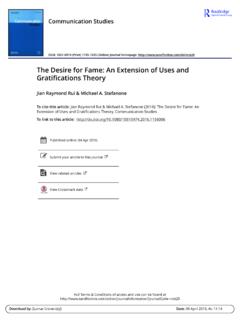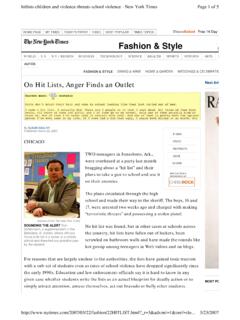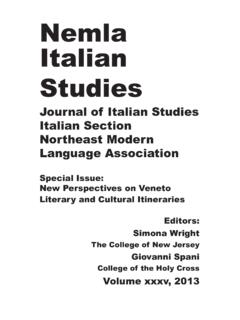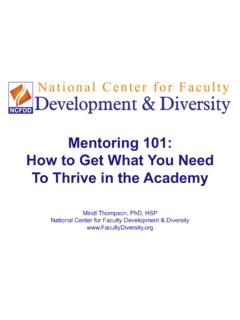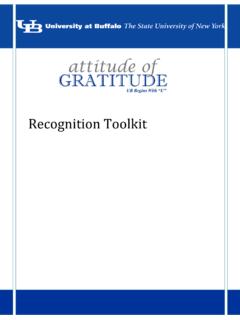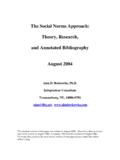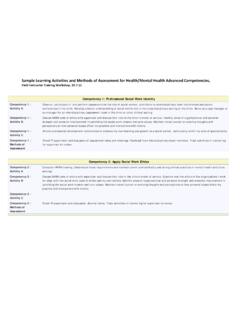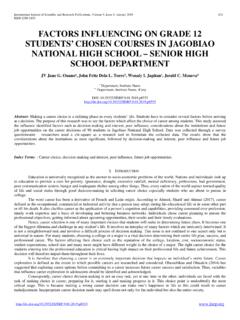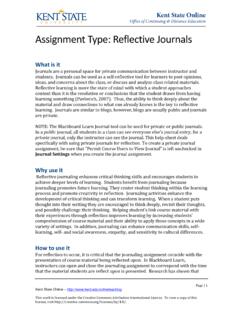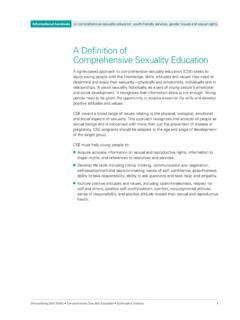Transcription of Exploring the relationship between perceptions of social ...
1 Journal of Computer-Mediated CommunicationExploring the relationship between perceptionsof social capital and enacted support onlineMichael A. StefanoneDepartment of communication , university at buffalo ,Kyounghee Hazel KwonCulture & communication , Drexel university ,Derek LackaffSchool of Communications, Elon university ,Online social networking sites enable users to connect with large, heterogeneous groups of extant research suggests individuals benefit psychologically from the perception that they arewell connected, little is known about the nature of tangible resources embedded in these onlinenetworks. In this study 49 participants sent 588 requests for instrumental help to their Facebookfriends to determine the accessibility of networked resources and online social capital. Almost 80% ofthese modest requests went unanswered, and perceived bridging and bonding capital did not explainenacted support. However, people who occupied socially prestigious positions were the most likely tobenefit from their friend s help.
2 These results suggest that expansive mediated networks may yieldlimited instrumental words:online social capital, social networks, enacted support, perceptions , always find themselves involved in social groups. Today, these groups are routinely mediatedby communication technology. Web the social web is characterized best as the set of toolsthat facilitate production and distribution of content produced by everyday people. In particular, thereis currently pervasive interest in the relationship between this content, (online) social networks, thenature of people s relationships mediated by websites like , and the changing role peoplenow play in the production and consumption of mass-mediated messages. Considering that sites facilitate the accumulation of expansive networks of acquaintances, there are pressingquestions about the relationship between the characteristics of online networks, access to social capital,and outcomes like psychological wellbeing and access to resources embedded in these networks are the conduit for the entirety of human social behavior and are comprised by arange of relationships with varying qualities.
3 Granovetter (1973, 1982) was the first to formalize thenature of relationship strength in social networks by arguing that social networks consist of relationshipsranging from very weak in strength to very strong. Weak and strong tie relationships afford access toJournal of Computer-Mediated Communication17(2012) 451 466 2012 International communication Association451different kinds of resources (Lin, 2001). For example, the strength of weak ties lies in their capacityto connect people to novel information and resources that reside in and propagate across networks(Hansen, 1999).Considering how connected people have become online and the evidence suggesting that usersare consequently better off (Ellison, Steinfeld, & Lampe, 2007), we propose to explore the nature ofthe relationships that comprise these networks and whether tangible, instrumental resources accrueto users. The current research reports on a quasi-experimental study designed to test the relationshipbetween requests for instrumental help via Facebook, the relationship characteristics between requestsenders and receivers, and actual, enacted support.
4 Grounded in the theory of instrumental action (Lin,1982) and limited to instrumental support, our goal is to establish a baseline for networked resourcesby Exploring the accessibility of social capital embedded in online of Self-InterestSocial scientists interested in self-interest as a motivation for social action (Coleman, 1986) suggestpeople make what they believe to be rational choices while pursuing objectives (Monge & Contractor,2003). People are not always objective, systematic beings (see for example, Frijda, 1986). However,rational choice theorists ( , Homans, 1950) outline a process in which people weigh outcomesbased on alternative actions and act based on the optimal solution to cost benefit analyses. Thisapproach suggests that people actively monitor and process environmental stimuli with the purpose ofmaximizing their individual of the literature on self-interest guided behavior grew out of research on status attainment( , Blau & Duncan, 1967).
5 The theory of instrumental action offers an alternative perspectiveby explicating the nature of relationships and embedded resources. While status attainment wasoperationalized as a function of given social network properties, status attainment can also be viewedas a product of strategic relationship ActionLin s (1982) theory of instrumental action suggests that people actively pursue opportunities andresources for their personal benefit. People have an intrinsic tendency to negotiate their socialenvironments in ways that maximize chances for personal gain. First, status in groups matters when itcomes to access to social resources. Consider the process of searching for employment social resources proposition of the theory of instrumental action states that if someone uses acontact higher in status than themselves to explore potential employment opportunities, they are likelyto find a better job than someone who uses a contact of lesser status (Lin, 1999).
6 Status in networks canbe inferred from formal hierarchies like organizational charts. However, social hierarchies also existoutside the boundaries of organizations. For example, some people have magnetic personalities thatmake them the center of attention, and physically attractive people are frequently the objects of others affection. Not surprisingly, it can be advantageous to be in positions like and Dumin (1986) focused explicitly on factors affectingaccessto social resources, concep-tualized as the way a person s network may connect them with a variety of different positions. Theyoperationalized strength of ties based on the nature of the relationship ; relatives were coded as strongties, friends as moderate strength ties, and acquaintances as weak ties. As expected, social contacts withhigh positions in networks and weaker tie affiliation (both friends and acquaintances) provided betteraccess to prestigious job opportunities, support for both the strength of positions and strength of ties452 Journal of Computer-Mediated Communication17(2012) 451 466 2012 International communication Associationpropositions reviewed above.
7 Further, weak ties were more instrumental for people whose originalpositions in the network were relatively low. It is unclear, however, whether or not weak ties mediatedby networking sites can be activated for instrumental together, the evidence summarized above suggests that structural characteristics of egonetworks and positions in social hierarchies influence access to and use of resources embedded insocial networks, or networked resources (Wellman & Frank, 2001). Overall, weak ties have greaterinstrumental functionality than strong ties, regardless of the structural location of those weak using people for instrumental goals, the literature suggests that the likelihood of others enactingsupport increases with social prestige, StatusMany definitions of social status have been proposed. For example, Moreno (1934) quantified conceptsof sociometric stars and isolates, where people situated in the center of star-shaped communicationnetworks benefit from higher levels of status, while isolates in networks exhibit lower levels.
8 Lin,Vaughn, and Ensel s (1981) model incorporated the socioeconomic status of personal contacts used tofind employment. This early iteration of the theory of instrumental action suggested that access to anduse of social resources play an important part in successful instrumental action. Essentially, the authorsargue that if social ties have different instrumental consequences, then the status of the contact shouldbe a good indicator of the structural advantage of the tie (p. 1166). We suggest that one form ofstatus popularity manifests itself via unreciprocated relationships. Celebrities are a good exampleof popular people as they are the object of attention and affection from mass audiences. Similarly, someFacebook users may benefit from having higher social status than others, and this characteristic of theirsocial position may affect access to resources embedded in social summary, Lin s (1982) theory of instrumental action describes goal directed behavior whichbenefits the person taking action.
9 Such behavior is defined as instrumental in nature and is restricted toactions that involve other people. social resources are embedded in social networks (Lin et al., 1981; Lin,2001), commonly known as social capital (Coleman, 1988) and these resources are used to maintainor promote an individual s welfare. Thus, the theory focuses on instrumental action initiated for thepurpose of gaining valued resources that reside in social CapitalAccording to Adler and Kwon (2002), social capital is roughly understood as the good will that isengendered by the fabric of social to facilitate action ( ). Other scholarsincluding Coleman (1988) and Kadushin (2004) emphasize that social capital is embedded in socialrelations that develop during the pursuit of instrumental goals. In sum, social capital can be definedas networked resources that are created, maintained, and realized by social relations occurring viamediated communication (Wellman & Frank, 2001). Lin (1999) proposes a clearly operationalizabledefinition of social capital as investment in social relations by individuals through which they gainaccess to embedded resources to enhance expected returns of instrumental or expressive actions ( ).
10 Lin s definition is particularly useful because it elucidates the social nature of support is one type of resource that is accessed through social networks, and refers toavailability of emotional and material support from others. Barerra (1986) suggests that social supportresearch should clearly differentiate among three major concepts: social embeddedness, perceivedsocial support, and enacted support. social embeddedness refers to the structures of relationshipsconnecting people. This is typically measured with social network analytic techniques which facilitateJournal of Computer-Mediated Communication17(2012) 451 466 2012 International communication Association453the quantification of structural properties of communication networks (Walker, Wasserman, &Wellman, 1994; Wellman, Carrington, & Hall, 1988; Wellman & Gulia, 1999; Wellman & Wortley,1990).Perceived social support is one of the broadest and most prevalent operationalizations in thesocial support literature (Barrera, 1986) and reflects idiosyncratic perceptions of support, rather thansocial structure.
